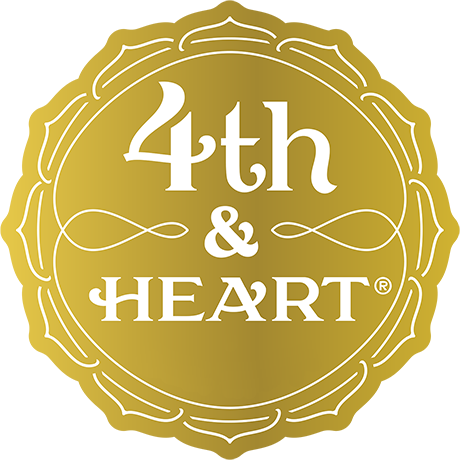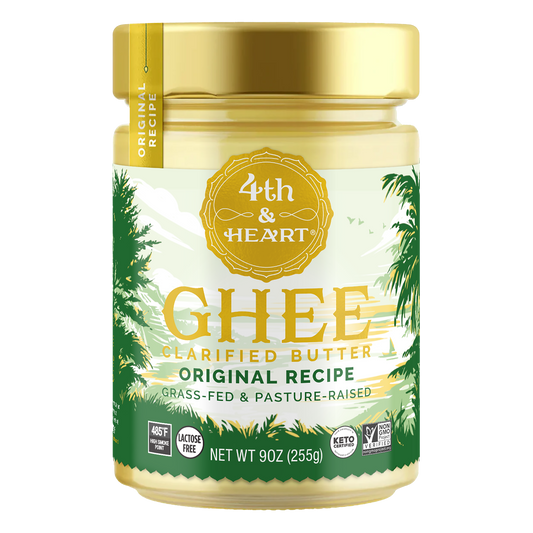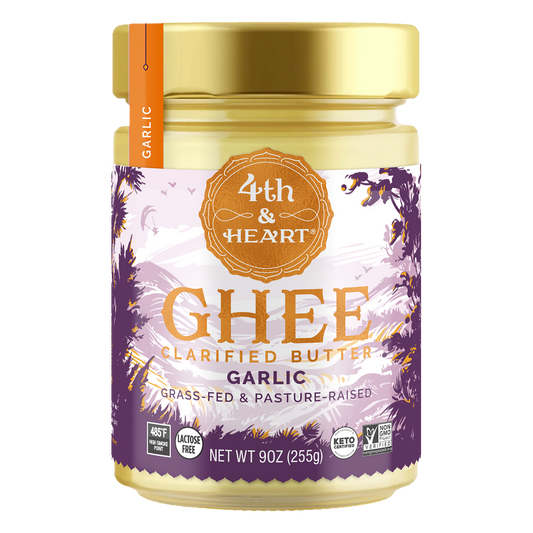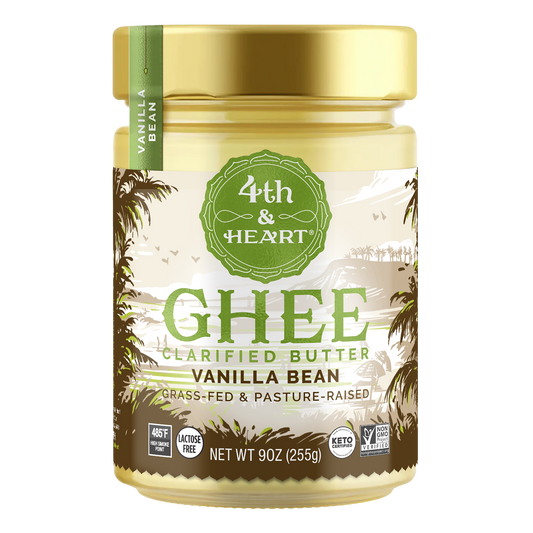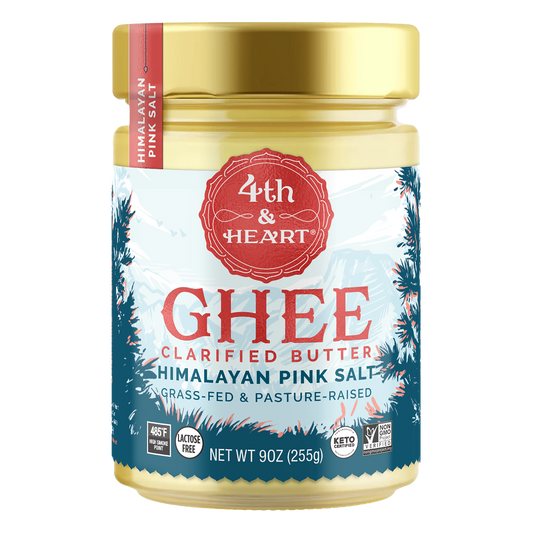Frequently Asked Questions
What is Ghee?
What is Ghee?
Ghee is a type of clarified butter that originated in India. It’s a rich, delicious, lactose-free alternative to butter and cooking oils. At 4th & Heart, we take butter from New Zealand and Australian grass-fed, pasture-raised cows and distill it down to its purest form. What’s left is 100% butterfat, with a creamy texture that spreads easily and is a 1:1 substitute for any butter or cooking oil.
Isn't ghee just clarified butter?
While ghee and clarified butter have similarities, they’re not exactly the same. Both ghee and clarified butter have water and milk solids removed, however the processes and end products differ slightly.
- Clarified butter is made by melting butter and allowing the water to evaporate. The milk solids separate and are removed. The process stops when the butterfat is clear, and the flavor is often mild.
- Ghee starts with the same process but continues to cook long after the water has evaporated, allowing the milk solids to brown slightly before going through a filtration process. This gives ghee a deeper, nuttier flavor, a slightly darker color and higher filtration than clarified butter.
What does ghee smell like?
Ghee smells like the richest of butters. It’s often described as warm, buttery, rich, nutty and sometimes with a hint of caramel. This distinctive smell is one of the reasons our ghee is highly valued in cooking as it adds a unique depth of flavor and aroma to dishes.
What does ghee taste like?
Ghee tastes like butter, but better. It has a rich, deep flavor with a complexity that regular butter lacks due to the browning of the milk solids during preparation. Because of this, it is a subtle, toasty flavor that elevates both savory and sweet dishes.
What is the history of ghee?
Ghee has been an important part of Indian culture for thousands of years. The word “ghee” itself comes from the Sanskrit word ghrita, which means “to sprinkle.” Ghee originated in India because the climate made it difficult to store butter for long periods of time, and through clarifying - removing the milk solids and water - it becomes shelf stable with a much longer shelf life. For thousands of years, ghee has been featured in Indian recipes, even in Hindu mythology, which attributes its origins to the divine. Today, ghee is widely available and is used as you would any other oil or fat: roast veggies, slather it onto meat to sear or grill, fry eggs with it, bake your favorite cookies or even stir it into your morning coffee.
Can butter be good for you?
Not all butter is created equal! 4th & Heart Ghee’s nutritional profile is different from butter. While our ghee is rich in saturated fats, these are medium-chain fatty acids that can be quickly metabolized by the body for energy. These fats can help support cellular health and provide a stable source of energy. Because of these medium-chain fatty acids, 4th & Heart Ghee helps break down fat-soluble vitamins such as A, D, E, and K, which are essential for various body functions including vision, bone health, immune function and antioxidant protection. Ghee is also a source of butyrate, a short-chain fatty acid that supports gut health and has anti-inflammatory properties. Ghee is naturally lactose and casein free which makes ghee suitable for those with common dairy sensitivities.
What are healthy fats?
Healthy fats are types of fats that have beneficial effects on your overall wellbeing, especially when consumed in moderation and as part of a balanced diet. Ghee contains medium-chain triglycerides (MCTs). These fatty acids are known for easily metabolizing in the body and are often used for energy rather than being stored as fat.
Is ghee diet friendly?
Ghee can be a friendly fat, especially within certain dietary frameworks. For those that adhere to low-carb or ketogenic diets, ghee is rich in healthy fats and medium-chain triglycerides (MCTs) which are essential for these types of diets. For those living a Paleo or Whole 30 lifestyle, ghee is a naturally and minimally processed fat in addition to being lactose/dairy free. In Ayurvedic diets, ghee is valued for its digestive benefits, including promoting a healthy gut and reducing inflammation. And for all other diets, the fats in ghee can promote feelings of fullness and satisfaction, which could help reduce overall calorie intake.
What are Ayurvedic principles?
Ayurvedic principles are based on the belief of maintaining balance and harmony between the body, mind, and environment to prevent and treat illness. Ayurveda places great emphasis on prevention and encourages the maintenance of health through close attention to balance in one’s life, right thinking, diet, lifestyle, and the use of herbs.
What is desi ghee?
Desi ghee refers to ghee made in the Indian subcontinent using historically traditional methods of preparation. It’s typically made from the milk of indigenous breeds of cows and emphasizes the traditional Indian method and cultural significance of ghee preparation.
What is cultured ghee?
Cultured ghee is a specific type of ghee that originated from cultured butter. Cultured butter has been fermented with bacterial cultures before it’s clarified into ghee. 4th & Heart does not make a cultured ghee.
Is ghee vegan?
While ghee is lactose-free, it is not vegan, as it’s made from cow’s milk butter. The milk solids are removed during the ghee-making process, but the final product is still a derivative of cow’s milk dairy.
Is 4th & Heart Ghee Vegetarian?
Yes 4th & Heart Ghee is considered a vegetarian product. Our ghee is 100% butterfat that comes from cow’s milk and therefore aligns with a vegetarian diet. It is important to note, however, that while our ghee is considered vegetarian, it is not a vegan product.
About 4th & Heart
What makes 4th & Heart Ghee “Better Butter"?
Our ghee starts with the finest butter sourced from grass-fed, pasture-raised New Zealand and Australian cows. Through our cooking process, it is distilled into the purest form of butter, 100% butterfat. 4th & Heart ghee is also naturally lactose-free. The rich, nutty, delicious flavor of our ghee elevates any dish, adding a more complex and deeper flavor.
Why should I use ghee instead of other oils or regular butter?
Ghee is a versatile fat that can be used anywhere you would use butter or other cooking oils like extra virgin olive oil! When heated to high temperatures, our ghee will maintain its molecular integrity and at its smoke point, ghee does not turn into a trans-fat, unlike other oils. Ghee can be used as a replacement for butter for those avoiding lactose and/or casein and it is shelf-stable and easy to store, making it a more versatile option for everyday cooking.
Is your ghee made with milk from grass-fed cows?
Yes! We only source Australian and New Zealand grass-fed, pasture-raised butter.
Does 4th & Heart Ghee contain lactose or milk allergens?
Because our ghee originates from cow’s milk, we declare it as an allergen on the packaging. However, lactose and casein are removed during the cooking and filtration process. We refer to lactose and casein as part of the “milk solids” that are filtered out, leaving pure butter fat.
Where do your ingredients come from?
All our ghee is made from New Zealand and Australian grass-fed, pasture-raised dairy. Additional ingredients for our flavored offerings are real, whole ingredients, sourced from the highest quality partners. We slow-steep our ghee with whole ingredients such as Madagascar vanilla beans, whole garlic cloves, and whole, peeled turmeric root to ensure a rich, delicious flavor throughout the ghee. We will never add highly processed powders and flavored oils to achieve our flavors.
How long does ghee last?
4th & Heart ghee has a shelf life of 18 months. We recommend consuming your ghee within 3 months of opening.
Is your ghee pasteurized?
Yes, our ghee is pasteurized, meeting food safety standards.
Is 4th & Heart Whole 30 compliant?
Yes! We’ve maintained a Whole 30 Certification since 2019.
Is 4th & Heart ghee kosher?
Yes – Kosher Dairy specifically and certified by Star K.
Is 4th & Heart ghee PALEO compliant?
Yes! We’ve maintained a PALEO certification since 2016.
Is 4th & Heart ghee KETO compliant?
Yes! We’ve maintained a KETO certification since 2018.
Is 4th & Heart ghee organic?
We do not have an organic offering at this time. Our focus has been on sourcing the finest butter made from grass-fed and pasture-raised cattle.
Is 4th & Heart Garlic Ghee FODMAPS friendly?
Yes, our Garlic Ghee is FODMAPS friendly!
What types of certifications do you have and why does that matter?
4th & Heart Ghee is Whole30, Keto, Paleo, Non-GMO, Gluten Free and Kosher Dairy certified. Additionally, our ghee is lab-verified lactose-free. Our certifications indicate high-quality, minimally processed products that are compliant with today’s preferred diets. Our maintenance of these official certifications demonstrates our commitment to the wellbeing of our customers and those they feed.
Why do you use grapeseed oil in your high heat ghee cooking spray?
Grapeseed oil is prized for its high smoke point, but also for its clean and compatible taste. Given that our ghee is a solid at room temperature, we blend it with other high-heat compatible cooking oils to maintain a liquid, sprayable form. We source only the very best grapeseed oil in our 4th & Heart Ghee Cooking spray to achieve the perfect consistency when spraying.
How is your grapeseed oil obtained?
Our grapeseed oil is a fruit oil derived from grapes, a 100% botanical source. It’s made from grape seeds as an upcycling part of the wine making process. After the grapes are pressed to extract the juice, seeds are left behind. These seeds are dried and cold-pressed to extract the oil. Cold-pressed they retain more nutrients and bioactive compounds through the cold-pressed method.
Does 4th & Heart contain other oils?
- Our 4th & Heart Ghee in both jar and stick form are made from 100% butter. No other oils are used in our ghee.
- Only 4th & Heart Ghee Spray contains additional oils, in the form of avocado and cold-pressed grapeseed oils.
Are there hidden ingredients?
We value transparency and will never hide or omit ingredients from our nutritional labels. All 4th & Heart products are made with the finest ingredients.
Why is my ghee melted or grainy?
The texture of ghee can sometimes vary, and sometimes it can arrive to you melted (liquid) or grainy depending on a few factors. Often in warm conditions (+85° degrees), ghee can become liquid. If your ghee is melted or grainy, it likely means it has been exposed to temperatures at or above this point. When the ghee re-solidifies, it might lose its creamy texture and become grainy. This graininess is due to the crystallization of the butterfat. Rest assured, the product is still safe to consume and has the same flavor you know and love. If you need to re-solidify your ghee after exposure to warm temperatures, you can place it in the fridge or freezer for a couple of hours.
Does your ghee need to be refrigerated?
Our jarred 4th & Heart Ghee does not have to be refrigerated after opening, it's shelf stable! We do recommend refrigerating our ghee sticks to help them keep their shape and make them easier to work with.
How do I recognize 4th & Heart packaging?
Our iconic 4th & Heart packaging is recognizable first with our foil brand logo. Our logo is constant across our packaging, representing the 4th Chakra in the body: the heart chakra. Each of our packages features unique landscapes from prominent California locations, representing where we were founded and where our ghee is made today.
What foods pair well with ghee?
Ghee pairs well with a wide variety of foods due to its rich, nutty flavor and high smoke point, making it an extremely versatile ingredient for many dishes. Historically, ghee has been a staple in Indian cuisine, but today it’s used in everything from vegetables, meat and seafood, to baking and breakfast foods. Ghee can be used anywhere you’d use butter or oil!
Why are your large format jars sold in PETplastic?
Plastic?! We hear you. Due to the weight of our larger size offerings, we opt to use jars made of PET, the most widely recycled plastic on the planet, to make sure that our large-size products don’t break in transport to you. When you buy our 9oz products at your local stores or online, our 4th & Heart Ghee will be in glass jars, however for our online sales, these larger formats will be in PET. We strongly encourage all our consumers to recycle their PET jars in accordance with local guidelines.
Where can I find 4th & Heart ghee in the grocery store?
- Our jarred ghee products and our ghee cooking oil spray can be found in the baking/cooking oils aisle.
- Our new ghee sticks can be found in the refrigerated butter section.
- You can find the nearest grocery store to you via our store locator tool.
What is lactose and what is lactose intolerance?
Lactose is a sugar found in the milk of all mammals. Lactose intolerance occurs when our bodies do not produce enough of an enzyme, specifically lactase, to digest the lactose in milk. Through the cooking and filtration process of 4th & Heart Ghee, we are naturally lactose-free, making it a great option for those who are avoiding lactose.
What is Casein?
Casein is a protein that is prevalent in cow’s milk. Like lactose, some people may have a sensitivity to casein which can cause a variety of symptoms. Through the cooking and filtration process of 4th & Heart Ghee, the casein is removed from our final product, making it a great option for those avoiding casein in their diet.
Why do you declare a MILK allergen on your packaging?
While our product is lab-tested as lactose and casein free, we feel it is important to remain transparent and notify consumers that our product originates from cow’s milk.
Does 4th & Heart make desi ghee?
No, we do not make desi ghee. 4th & Heart makes ghee using traditional methods in Northern California with grass-fed, pasture raised Australian and New Zealand Cows. While we leverage modern dairy practices, we do still follow the principles of traditional ghee-making.
How Do I Use Ghee?
How do I start using ghee in place of butter?
Ghee can generally be substituted in a 1:1 ratio for butter. This means that in a recipe that calls for 3 tablespoons of butter, you can use 3 tablespoons of 4th & Heart Ghee. It’s great for cooking, sauteing, baking, as a spread or condiment, delicious for roasting meats, and as a flavor enhancer or a finishing touch!
How do I bake with ghee?
Substitute ghee for butter in cookie and cake recipes – the ratio is typically 1:1, but you might want to slightly adjust the amount of liquid if the dough or batter seems too dry. For pastries, ghee creates an enhanced, deeper flavor. In muffins or breads, a 1:1 replacement can add moisture to delicious baked goods.
How do I cook with ghee?
Ghee can generally be substituted in a 1:1 ratio for butter. Use it as you would any other butter or cooking oil to fry, sauté, roast, bake, make sauces, on pasta and grains, as a spread or topping, or in breakfast dishes like pancakes and waffles, oatmeal or even when cooking eggs!
How can 4th & Heart elevate my cooking?
4th & Heart Ghee can elevate your cooking by providing a versatile alternative to traditional fats. With a high smoke point of 485°F, it’s perfect for sautéing, frying, and roasting without burning. Its rich, nutty flavor enhances both savory and sweet dishes, from vegetables and meats to popcorn and coffee. Ghee is naturally lactose-free, making it suitable for those with dairy sensitivities. Additionally, ghee is easy to use, has a long shelf life without refrigeration, and can be infused with spices for added flavor.
What is the best way to grill with ghee?
Grilling with ghee can add a rich, nutty flavor to your food and help achieve a beautifully caramelized crusted exterior. Ghee can be used as a marinade with herbs and spices to enhance any dish. Ghee is great to brush on the grill to help create a nonstick surface as well as onto foods as they grill. It’s great mixed in with roasted vegetables, on garlic bread, or on skewers to enhance flavor.
How many sticks of ghee butter are in a package of 4th & Heart ghee sticks?
There are 2 - 4oz ghee sticks per package of 4th & Heart ghee sticks.
How many sticks of ghee butter are in a jar of 4th & Heart ghee?
- There are 2.25 sticks of traditional butter in our original, 9oz jar.
- There are 4 sticks of traditional butter in our 16oz jar.
- There are 8 sticks of traditional butter in our 32oz jar, sold exclusively on Amazon.
Does your ghee need to be refrigerated?
4th & Heart ghee jars are shelf stable and do not require refrigeration. While our ghee sticks are shelf stable from a food safety standpoint, we recommend refrigerating our ghee sticks to help them keep their shape and make them easier to work with.
What is the ghee smoke point and why does that matter?
The high smoke point of ghee (485°) matters because it makes ghee an excellent choice for a wide variety of cooking methods, especially those that involve high heat. This high smoke point, significantly higher than regular butter and olive oil, ensures ghee can be heated to much higher temperatures without burning or smoking. When fats are heated beyond their smoke points, they break down and degrade, losing nutritional value. Ghee’s stability at high temperatures helps preserve its nutritional properties without turning to free radicals. By using 4th & Heart Ghee for high-heat cooking, you can achieve better-tasting, more consistent results, making it a valuable ingredient for any dish!
Why should I use ghee?
Ghee offers a rich, nutty, complex flavor that enhances the taste of your favorite dishes. It makes grilled cheese crispier and sears steaks perfectly, leaving behind that delicious crust. It adds depth to sautés and vegetables and adds an edge to your morning coffee. And, because we remove all the milk solids during the cooking process, ghee is the perfect fit for diets like the Whole 30, Keto, and Paleo, while being naturally lactose-free.
Farming Practices
Do you use milk from cows treated with rBST or Growth Hormones?
We do not use milk from cows treated with rBST or Growth Hormones.
Do you have your own cows?
No, we do not have our own cows. We have very strong partnerships with farmers who meet our quality and animal welfare standards. This allows us to ensure not only that our animals are well cared for but also allows us to ensure consistent quality and availability of our ghee.
What are your farming practices?
We believe in the very best treatment for our animals, ensuring they live a happy, healthy life. Because of this, we only source our butter from New Zealand and Australia, two countries at the forefront of both grass-fed, pasture-raised dairy and animal welfare practices. We work with dairy farming partners that share in these beliefs. Our cows will never receive any growth hormones or be subjected to industrial farming practices (think big animals in small cages – NO!). They are exclusively grass-fed, pasture-raised, and milked no more than twice per day.
Why do you source New Zealand and Australian Butter?
We believe these two countries produce some of the highest quality butter of anywhere in the world. The temperate climate and lush green vegetation enable the cows to be exclusively grass-fed and pasture-raised. This leads to butter that is a deeper golden color and richer in flavor than elsewhere around the world. Additionally, both of these countries have some of the most rigid animal welfare standards in the world and top-notch quality control practices.
What type of Cows does your dairy come from?
Holstein and Jersey dairy cows.
What are your cows fed?
Our cows are pasture-raised, meaning their diets predominantly consist of wild grasses.
What are A1 and A2 cows?
The difference between A1 and A2 cows is based on their breed and the type of milk proteins (beta-casein) they produce. As the milk proteins are filtered out through our process, we do not source specifically A1 or A2 dairy.
What animal welfare practices do you follow?
We firmly believe that animals have the right to be treated humanely, which is why we work with partners that exclusively employ grass-fed, pasture-raised farming practices. We hold our supply partners to rigorous standards that strictly prohibit the use of industrial farming practices, non-therapeutic antibiotics, growth hormones and over-milking. If a cow should need therapeutic antibiotics due to illness, that cow is then isolated and cared for under the supervision of a certified veterinarian.
About Us / Product Availability
I’d prefer to shop local. Where can I find 4th & Heart Ghee?
You can find 4th & Heart ghee in over 12,000 stores nationwide. We’re proud to partner with stores large and small to bring our ghee to consumers across the country. To find a store near you, visit our store locator.
Where can I buy this product online?
4th & Heart Ghee is available online through a variety of online retailers. You can purchase ghee online via our online store, Amazon.com, or through preferred grocers via Instacart.
Is 4th & Heart Ghee available in a store near me?
4th & Heart is available at over 12,000 stores nationally. To find a store nearest you, visit our store locator.
Do you ship internationally?
No, we do not ship internationally.
How can I get in touch with the 4th & Heart team?
For customer service inquiries, reach out to our team by email at wecare@4thandheart.com, or by filling out our Contact Us form.
How can I place a 4th & Heart wholesale order?
For wholesale orders, please reach out to our team by email at orders@4thandheart.com.
Can I recycle 4th & Heart packaging / jars?
Our 4th & Heart Ghee jars are recyclable! Simply remove the label, and recycle the glass jar, throwing the label away. Our 4th & Heart Ghee sticks box is also recyclable. Always check your local recycling guidelines before recycling.
Does your packaging contain PFAs?
No! We only work with packaging supply partners who utilize raw materials and processes that are free from PFAs (perfluoroalkyl or polyfluoroalkyl substances – aka “forever chemicals”).
Take a chance on ghee:
-
Original Ghee
Regular price From $12.99Regular priceUnit price / per -
Garlic Ghee
Regular price $12.99Regular priceUnit price / per -
Vanilla Bean Ghee
Regular price From $14.99Regular priceUnit price / per -
Himalayan Pink Salt Ghee
Regular price From $12.99Regular priceUnit price / per
